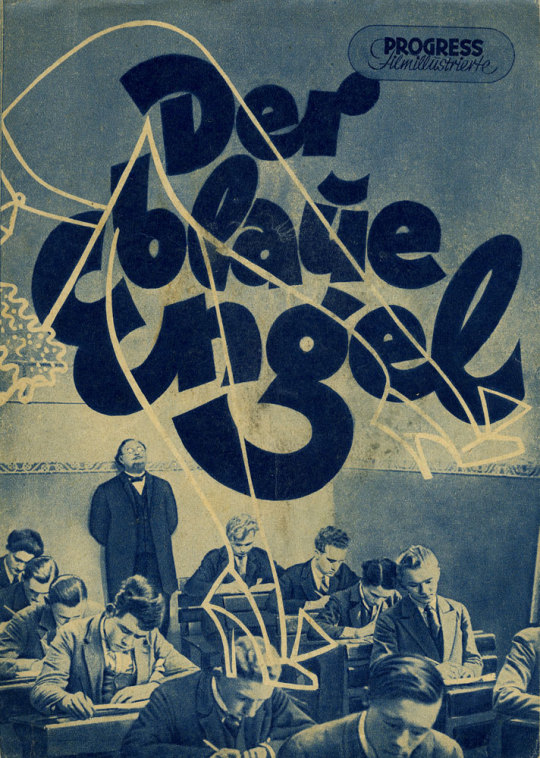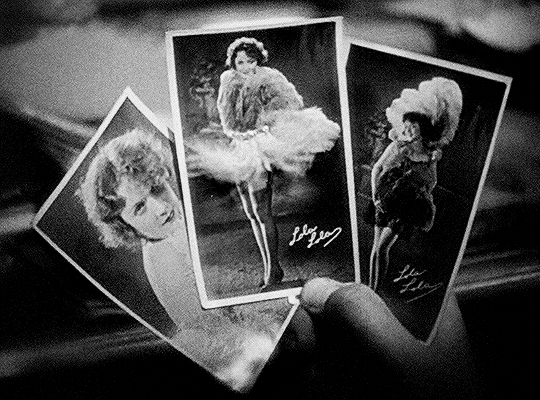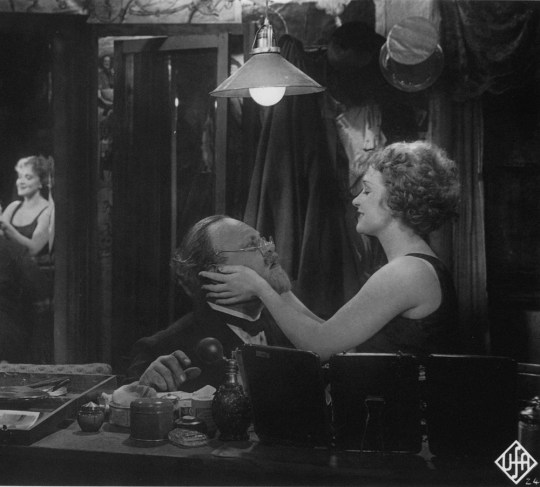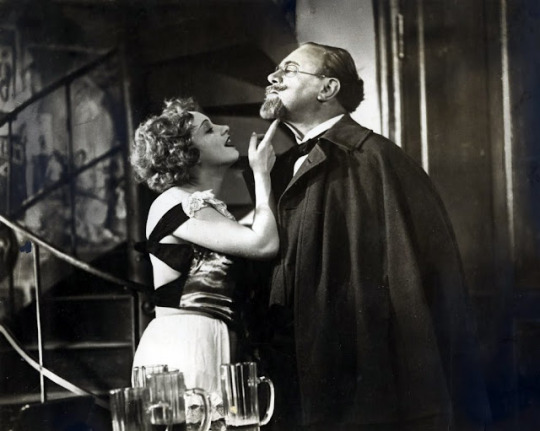#rosa valetti
Explore tagged Tumblr posts
Text

[Note: This poll is a re-do of an older poll, as the original poll for it received less than 2,000 votes.]
#polls#movies#the blue angel#the blue angel 1930#the blue angel movie#30s movies#josef von sternberg#emil jannings#marlene dietrich#kurt gerron#rosa valetti#hans albers#have you seen this movie poll#redone poll
15 notes
·
View notes
Text

Wir konnten dann sogar einen Geburtstagsfilm für Marlene anbringen, diesmal sogar endlich wieder den unter Bildungbsürgern als bedeutsam geltenden (der Bruder des Autors der Romanvorlage erhielt den Literaturnobelpreis!) und besonders wirkungsmächtigen, der aber wenn man ehrlich ist, so weit von The Devil Is A Woman auch nicht weg ist. Für das Männermordende-Vamp-Fach ist Marlenes hier letzmals verwendete Piepsestimme recht ungewöhnlich.

#Der blaue Engel#Emil Jannings#Marlene Dietrich#Rosa Valetti#Kurt Gerron#Hans Albers#Film gesehen#Josef von Sternberg#Friedrich Holländer#Heinrich Mann
0 notes
Text

Helmut Kolle - Die Schauspielerin Rosa Valetti
8 notes
·
View notes
Photo







The Blue Angel (Der blaue Engel) (1930) Josef von Sternberg
September 5th 2021
#the blue angel#der blaue engel#1930#josef von sternberg#emil jannings#marlene dietrich#kurt gerron#rosa valetti#reinhold bernt#hans albers#rolf muller#carl balhaus#ilse furstenberg#professor unrat
28 notes
·
View notes
Photo

Marlene Dietrich and Rosa Valetti in The Blue Angel (Josef von Sternberg, 1930)
34 notes
·
View notes
Photo




Herr Tartüff (F.W. Murnau, 1925).
59 notes
·
View notes
Photo

The Blue Angel (1930, Germany)
With the silent era at its conclusion and the rise of Nazism upcoming, German cinema’s brief early sound era shows the visual mastery of what might have been. The Blue Angel is Germany’s first feature-length synchronized sound film and is helmed by Austrian-American Josef von Sternberg in his only German-language production. Von Sternberg had directed a handful of films for Paramount prior to The Blue Angel, including The Docks of New York (1928) and The Last Command (1928). Thematically, The Blue Angel – produced by Universum Film AG (UFA) and distributed in the United States by Paramount – is a departure from von Sternberg’s previous films, while also adopting the aesthetic influences of German expressionism. In these precious few years following the heights of German silent film glory, the audience is treated to a talkie that always feels like a silent film. That incongruity never distracts, and only serves to demonstrate how remarkable The Blue Angel is in an experimental period of filmmaking – a period where few filmmakers could balance the needs of image and sound.
In Weimar Germany, disciplinarian professor Immanuel Rath (Emil Jannings) is the target of pranks and barbed words from his students at an all-male college prep school. One day, he is particularly annoyed by the boys passing around photographs of cabaret performer Lola Lola (Marlene Dietrich). Lola performs at a local nightclub called The Blue Angel, and Rath visits in hopes to catch his students there. His students are present, but Rath is overcome by lust after watching Lola perform. Returning the next night with a pair of her panties (that one of his students smuggled into his pocket), he spends the night with her. Rumors spread like the flu, Rath is dismissed from his professorship, and allows himself to be humiliated for what he thinks is love. His downfall is sealed.
The Blue Angel is a tragedy, but has more to do with Greek drama than Shakespeare – the former emphasizes the inescapability of divine fate and the role of human hubris in believing predestination can be overcome; the latter is dictated on the free will of an individual and how their character flaws result in their demise (the flaw need not be hubris, but it is often invoked by Shakespeare). According to von Sternberg, The Blue Angel is making no attempts at political allegory, so his intentions are purely personal. As Rath, Jannings plays his character as a rebuke to the besotted silent film romances seen across Western cinema. Unlike Heinrich Mann’s novel on which this film is based on, The Blue Angel never allows Rath to change himself over the course of his relationship with Lola. Maybe the audience should have sensed this earlier: his personality, his sense of order in the classroom was of strict control. Believing in his intelligence and ability to control his emotions and the situation, he stumbles upon Lola, holding her up to an image of perfection, and believing in that image steadfastly until he finally sees otherwise.
As the film’s seductress, Lola is a charismatic fantasy that men desire (permit some heteronormative language in respect to what the film depicts). But what people desire and what they need are distinct – something that neither Rath nor Lola ever understand. In her introductory scene, Lola is performing onstage, essentially opening herself to the unprocessed feelings of lustful men (young and old). She purrs, “... I have a pianola / that is my joy and pride. / They call me naughty Lola; / the men all go for me. / But I don’t let any man / lay a paw on my keys.”
What does Lola see in Rath that makes her want to be with him? They marry and it is implied that they become intimate. Her side of the relationship alternates between fits of passion and vitriol; intimacy and unfaithfulness; attention and apathy. Amid a society where cabaret performers like Lola could be seen as flighty and licentious, in Rath Lola sees someone who thinks otherwise. But instead of attempting to understand Lola’s anxieties and weaknesses – the viewer senses that, beneath her erotic public performances, there is more to this character that is never depicted – Rath views her as a romantic nonpareil. His ability for critical thought disappears when it comes to this sort of relationship he might never have experienced; his ability for self-reflection tainted by an unbending, stern, studious approach to his students. For her, Rath presents an opportunity to be accepted as something magnificent, something pure that which she nor anyone ever will be.
The film’s sensitivities are with Rath, not Lola. Even in Rath’s most despicable moment, von Sternberg and fellow co-screenwriters Carl Zuckmeyer, Karl Vollmöller, Robert Liebmann ensure that The Blue Angel remains within the tradition of Greek tragedy (with a twist). Where in the original novel Rath embarks upon exacting revenge against the authoritarian society that has shaped his interactions with students, there is no such redemption here. Rath is punished for his dangerous lustfulness – as he should be. Curiously, the predatory Lola – despite becoming a victim of attempted violence in the final minutes – escapes punishment of any type. In Rath’s tragedy, she has discarded what she no longer wants and has gained something/someone she presently desires. No remorse is present, nor does there appear to be any emotional trauma from ending her relationship with Rath. Perhaps the audience should have expected this, given the lyrics to the memorable “Falling in Love Again”, sung by Dietrich twice with music by Friedrich Hollaender and lyrics by Robert Liebmann (these lyrics are from the English-language version of this song; Hollaender adjusted the songs to accommodate Dietrich’s limited, but effective, vocal range):
Love's always been my game, Play it how I may, I was made that way, Can't help it.
If The Blue Angel had been produced primarily in the United States later in the 1930s, this ending could not have been upheld by the censors. Love (or romance or whatever you wish to call it), to Lola, is a fun game to play. And playing by her rules, she has always won. Where Rath experiences a tragedy befitting a German expressionist protagonist, Lola’s inconclusive fate feels contemporary regardless of the film’s Weimar morals.
The film collapses without the performances from its two central stars. Before release, Jannings was the lead if one looked at the billing. He had just won the inaugural Academy Award for Best Actor in von Sternberg’s The Last Command and 1927′s The Way of All Flesh (actors were listed for multiple movies at the first Oscars) – this film was to be his nominal pinnacle. Jannings excelled in playing tortured, disgraced characters and could do no greater here with his physical acting. His performance would be just as spellbinding if The Blue Angel was a silent film. However, Jannings is upstaged by Dietrich the moment she appears on-screen. Dietrich, playing an intemperate woman, became an instant sensation to European and American audiences in this, her twentieth film (and first talkie). But her success in The Blue Angel also served to typecast Dietrich into roles unscrupulous and indiscreetly erotic – pursuing sexual satisfaction at the expense of others’ needs. Von Sternberg doted on Dietrich during production, sparking the ire of Jannings (who entered production hoping to become next Hollywood star, but instead saw his career plummet afterwards due to his heavy German accent and subsequent work Nazi propaganda films) and von Sternberg’s wife (who filed for divorce after the film’s release). Her sensuality defined this film, whether or not the cameras rolled.
Manning the cameras was veteran cinematographer Günther Rittau (Die Nibelungen saga, 1927′s Metropolis). Rittau captures the smoky interior of The Blue Angel nightclub and the seedy nighttime of this unnamed German town to convey a sense of enclosure. Art director Otto Hunte (Die Nibelungen saga, Metropolis) employs distorted geometries – early shots of angled rooftops and jagged roads primes the imagination for the unconventional story to come – and exaggerated shapes and lighting to assist Rittau in achieving the film’s wondrous atmosphere.
This film, like many in the early years of synchronized sound, was shot in two different languages – German and English (yes, the actors had to shoot every seen and recite their lines twice). The above has been written based on the 107-minute uncut German-language version distributed by Kino International, licensed by the Murnau Foundation, and aired on Turner Classic Movies (TCM). Consensus says that the German-language version is superior to the English edition.
Predictable though it might be, The Blue Angel is a forceful statement of German filmmaking – it is a film honoring the expressionist past while showcasing its future (a future where many of its innovators would flee the Nazis and work in Hollywood). It would also be one of UFA’s final classics – the studio also released Robert Wiene’s The Cabinet of Dr. Caligari (1920), F.W. Murnau’s The Last Laugh (1924), and Fritz Lang’s visionary Metropolis. Von Sternberg’s film, reflecting the drama behind the cameras, is a romantic tragedy that sings of love even when its characters know little about it. The Blue Angel is a triumph that quickly became written into German cinematic history. Its rapid ascent into that history can be attributed to the political changes soon to uproot all that German filmmakers had nourished. This film could not have been made any better in any other time.
My rating: 9.5/10
^ Based on my personal imdb rating. Half-points are always rounded down. My interpretation of that ratings system can be found here.
#The Blue Angel#Josef von Sternberg#Emil Jannings#Marlene Dietrich#Kurt Gerron#Rosa Valetti#Hans Albers#Reinhold Bernt#Eduard von Winterstein#Gunther Rittau#Otto Hunte#Friedrich Hollaender#Robert Liebmann#Carl Zuckmayer#Karl Volllmoller#TCM#My Movie Odyssey
3 notes
·
View notes
Photo

der raub der mona lisa (1931)
0 notes
Photo


Films Watched in 2019:
27. Herr Tartüff/Tartuffe (1925) - Dir. F.W. Murnau
#Herr Tartüff#Tartuffe#F.W. Murnau#Emil Jannings#Lil Dagover#Werner Krauss#Rosa Valetti#André Mattoni#Hermann Picha#German Expressionism#Silent Cinema#sfw#Films Watched in 2019#My Edits#My Post
1 note
·
View note
Photo

Nun aber doch wieder etwas ernstes und relevantes für die Kinogeschichte. In kunstvoller, doch dokumentarisch präziser Fritz-Lang-Optik: Eine Stadt sucht einen Mörder. Es handelt sich um den späteren japanischen Superagenten Peter Lorre. Er kann doch aber gar nichts dafür, für diesen unwiderstehlichen Drang... (einiges bleibt unausgesprochen). Die Herren Verbrecher unter der Leitung des späteren Staatsrats Gründgens hingegen, die müssten sich ja bloß ein bisschen Mühe geben und etwas ordentliches lernen. Nee, stattdessen wollen sie ihm den Garaus machen, und zwar gerade, als die akribische Aufklärungsarbeit der nimmermüden Kriminalpolizei ihn auch erwischt hätte. Nun müssen sie ihn zu allem Überfluss auch noch aus den Klauen des finsteren Mobs befreien, man hofft, um ihm eine angemessene psychiatrische Betreuung zukommen zu lassen, glaubt aber nicht recht dran.
#Film gesehen#M#M – Eine Stadt sucht einen Mörder#Fritz Lang#Peter Lorre#Gustaf Gründgens#Otto Wernicke#Theo Lingen#Rosa Valetti
1 note
·
View note
Text
[Last Film I Saw] M (1931)
[Last Film I Saw] M (1931)
Title: M Year: 1931 Country: Germany Language: German Genre: Crime, Drama, Thriller Director: Fritz Lang Writers: Thea von Harbou Fritz Lang Cinematography: Fritz Arno Wagner Cast: Peter Lorre Otto Wernicke Rosa Valetti Ellen Widmann Franz Stein Georg John Friedrich Gnaß Fritz Odemar Paul Kemp Theo Lingen Gustaf Gründgens Theodor Loos Rudolf Blümmer Inge Landgut Rating: 9.0/10

My words may be…
View On WordPress
#1931#9.0/10#Black & White#Ellen Widmann#Franz Stein#Friedrich Gnaß#Fritz Lang#Fritz Odemar#Georg John#German Film#Gustaf Gründgens#Inge Landgut#Otto Wernicke#Paul Kemp#Peter Lorre#Rosa Valetti#Rudolf Blümmer#Theo Lingen#Theodor Loos
0 notes
Photo

Marlene Dietrich and Emil Jannings in The Blue Angel (Josef von Sternberg, 1930) Cast: Emil Jannings, Marlene Dietrich, Kurt Gerron, Rosa Valetti, Hans Albers, Reinhold Bernt, Eduard von Winterstein, Hans Roth, Rolf Müller, Roland Varno, Carl Balhaus, Robert Klein-Lörk, Károly Huszár, Ilse Fürstenberg. Screenplay: Carl Zuckmayer, Karl Vollmöller, Robert Liebmann, based on a novel by Heinrich Mann. Cinematography: Günther Rittau. Art direction: Otto Hunte. Film editing: Sam Winston. Music: Friedrich Hollaender Josef von Sternberg's The Blue Angel still has some of the earmarks of a film made during the transition from silence to synchronized sound, namely the tendency to hold a shot a beat or two longer than is actually necessary, so the narrative doesn't always move along at the speed we anticipate. But Sternberg is clearly ready for sound, as the final scene shows. The camera tracks back from the dead professor, clutching his old desk so tightly that the caretaker who found his body has been unable to loosen his grip. Meanwhile, we hear the clock striking midnight, with the twelfth stroke barely audible as the screen fades to black. It's a touching moment, made possible by the several shots and sounds of the clock that occur through the film as a kind of indicator of Rath's decline from precise and punctual to dissipated and tardy. Otherwise the sound on the film is sometimes a little harsh to the ear, which makes Sternberg's relatively sparing use of it welcome. Many scenes are staged in near-silence, letting the action rather than the dialogue carry the story. Marlene Dietrich's baritone recorded well, which is one reason her career took off when sound was introduced, but early in the film she's allowed to sing in an upper key which is more than a little off-putting. Fortunately, by the time we get to Lola Lola's big number, Friedrich Hollaender's "Ich bin von Kopf zu Fuß auf Liebe eingestellt" (the subtitles use the English language version, "Falling in Love Again" instead of a literal translation), Dietrich is back in the correct register. The Blue Angel thrives on Dietrich's performance, which eclipses Emil Jannings's overacting, though he does provide some genuine pathos toward the end of the film. I don't quite believe the ease with which the professor falls from grace, but I'm not sure whether the fault lies entirely with Jannings or with the screenplay.
0 notes
Text
M (1931) – Episode 113 – Decades of Horror: The Classic Era
"That is a nice ball you have." Creepy? Yes! Very creepy. Join this episode’s Grue-Crew - Whitney Collazo, Chad Hunt, Daphne Monary-Ernsdorff, and Jeff Mohr - as they take in what might well be the prototype serial killer film, Fritz Lang’s M (1931), starring Peter Lorre.
Decades of Horror: The Classic Era Episode 113 – M (1931)
Join the Crew on the Gruesome Magazine YouTube channel! Subscribe today! And click the alert to get notified of new content! https://youtube.com/gruesomemagazine
ANNOUNCEMENT Decades of Horror The Classic Era is partnering with THE CLASSIC SCI-FI MOVIE CHANNEL which will now include video episodes of The Classic Era! Available on Roku, AppleTV, Amazon FireTV, AndroidTV, Online Website. Across All OTT platforms, as well as mobile, tablet, and desktop. https://classicscifichannel.com/
When the police in a German city are unable to catch a child murderer, other criminals join in the manhunt.
IMDb
Director: Fritz Lang
Writers: Thea von Harbou (script), Fritz Lang (script)
Cinematographer: Fritz Arno Wagner
Selected Cast
Peter Lorre as Hans Beckert
Otto Wernicke as Inspector Karl Lohmann
Gustaf Gründgens as Der Schränker (The Safecracker)
Ellen Widmann as Mother Beckmann
Inge Landgut as Elsie Beckmann
Theodor Loos as Inspector Groeber
Friedrich Gnaß as Franz, the burglar
Fritz Odemar as Falschspieler (Cheater)
Paul Kemp as Taschendieb (pickpocket with seven watches)
Theo Lingen as Bauernfänger (con man)
Rudolf Blümner as Beckert's defender
Georg John as blind balloon-seller
Franz Stein as minister
Ernst Stahl-Nachbaur as police chief
Gerhard Bienert as criminal secretary
Karl Platen as Damowitz, a night-watchman
Rosa Valetti as innkeeper
Hertha von Walther as prostitute
Hanna Maron (uncredited) as girl in circle at the beginning
Heinrich Gotho as passer-by who tells a kid the time
Klaus Pohl as witness / one-eyed man (uncredited)
Daphne is taken in by Fritz Arno Wagner’s beautiful cinematography and Peter Lorre’s mind-blowing performance. She is also intrigued with how Lang uses sound, emphasizing silence as much as sound. Certain elements of M, for instance, the pacing, make it hard for Whitney to get into the film. On the other hand, she enjoys Peter Lorre’s performance and is definitely creeped out by some scenes. M seems almost like two different movies to Chad. The pacing during the first half is not to his liking, but once everyone is on the trail of Peter Lorre’s character, he really got into it. And, of course, Peter Lorre for the win! Jeff loves M and could watch it just for the cinematography and Peter Lorre’s acting.
You know you want to check out or revisit M, right? At the time of this writing, it is available to stream from HBO max, the Criterion Channel, and Kanopy. M is also available on physical media as a Criterion Collection Blu-ray.
Gruesome Magazine’s Decades of Horror: The Classic Era records a new episode every two weeks. Up next on their very flexible schedule is one chosen by Daphne: Charles Laughton’s The Night of the Hunter (1955), starring Robert Mitchum, Lillian Gish, and Shelley Winters. You will not want to miss that one!
Please let them know how they’re doing! They want to hear from you – the coolest, grooviest fans: leave them a message or leave a comment on the site or email the Decades of Horror: The Classic Era podcast hosts at [email protected]
Check out this episode!
1 note
·
View note
Photo


Herr Tartüff (F.W. Murnau, 1925).
#herr tartüff (1925)#herr tartüff#f.w. murnau#molière#carl mayer#rosa valetti#karl freund#robert herlth#walter röhrig#waldemar jabs
24 notes
·
View notes
Link
0 notes